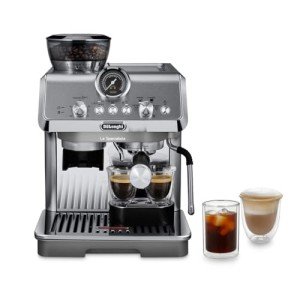How To Beat Your Boss On Dual Boiler Espresso Machines

Understanding Dual Boiler Espresso Machines: A Comprehensive Guide
Espresso is an art as much as it is a science. For coffee enthusiasts and baristas alike, accomplishing the ideal shot of espresso demands precision and control over brewing variables. One of the most efficient ways to achieve this accuracy is through the use of dual boiler espresso machines. This article digs into the performance, advantages, and considerations of dual boiler espresso machines for both newbies and knowledgeable coffee aficionados.
What is a Dual Boiler Espresso Machine?
A dual boiler espresso machine features 2 different boilers: one for developing espresso and the other for steaming milk. This style enables the user to brew coffee and steam milk concurrently, achieving ideal temperature control for both procedures. This is vital for developing lattes, coffees, and macchiatos, where both ingredients are necessary.
Table 1: Key Components of Dual Boiler Espresso Machines
| Part | Function |
|---|---|
| Espresso Boiler | Heats water to the perfect developing temperature (around 190 ° F) |
| . Steam Boiler | Warms water to a higher temperature (around 250 ° F) for steaming milk. |
| PID Controller | Regulates the temperature of the boilers for accuracy developing. |
| Group Head | Where the coffee grounds sit and warm water goes through. |
| Steam Wand | Provides steam to froth milk. |
Advantages of Dual Boiler Espresso Machines
1. Simultaneous Brewing and Steaming
The most substantial benefit of dual boiler espresso machines is the capability to brew espresso and steam milk at the exact same time. This performance is particularly useful in busy environments, such as coffee shops, where speed and quality are vital.
2. Consistent Temperature Control
Dual boiler machines typically come with innovative PID (Proportional Integral Derivative) controllers that keep a constant temperature throughout the developing process. Consistency is essential in espresso making to make sure the best extraction, hence improving taste and fragrance.
3. Modification and Versatility
With 2 different boilers, users can customize the temperature level settings for both espresso brewing and milk steaming. This suggests different kinds of coffee, such as lighter or darker roasts, can be prepared completely to suit individual taste profiles.
4. Ideal for Advanced Techniques
For those thinking about latte art or other sophisticated techniques, a dual boiler espresso machine provides the versatility to work with numerous milk textures while also drawing out espresso. Commercial Espresso Machines makes it an appealing option for baristas who want to develop their abilities.
5. Durability and Durability
Numerous dual boiler machines are developed with high-quality products designed for durability. They are typically made from stainless steel and function long lasting parts, making them a rewarding financial investment for anybody severe about coffee.
Disadvantages of Dual Boiler Espresso Machines
Regardless of their various benefits, dual boiler machines can have some drawbacks:
- Higher Cost: Dual boiler machines tend to be pricier than their single-boiler counterparts, which might not appropriate for casual coffee drinkers.
- Size and Space: These machines might inhabit more counter top space than others, making them less perfect for small kitchens.
Table 2: Key Considerations When Choosing a Dual Boiler Espresso Machine
| Consideration | Explanation |
|---|---|
| Budget | Dual boiler machines can vary from ₤ 1,000 to over ₤ 4,000. |
| Size | Inspect your kitchen area area before purchasing. |
| Brand name Reputation | Search for well-reviewed brand names with great consumer assistance. |
| Functions | Consider what features are important (e.g., PID controller, volumetric options). |
| Maintenance | Some machines may need more regular upkeep than others. |
Frequently asked questions
1. Are dual boiler espresso machines worth the investment?
Yes, they are worth the investment for serious coffee lovers or professional baristas who value accuracy in espresso extraction and milk steaming.
2. How do I maintain a dual boiler espresso machine?
Routine upkeep consists of descaling the machine, cleaning the group head, and ensuring that the steam wand is devoid of milk residue. Speak with the manufacturer's manual for particular guidelines.
3. Can I use a dual boiler espresso machine for other brewing techniques?
Typically, dual boiler machines are designed generally for espresso. However, they can usually brew quality drip coffee and other styles with the right settings and modifications.
4. What brand names are known for their dual boiler machines?
Some trustworthy brands consist of La Spaziale, Breville, and ECM. Each brand has its own unique functions and pricing.
5. What is the typical life expectancy of a dual boiler espresso machine?
With correct care and upkeep, a dual boiler machine can last over a decade, making it a long-lasting investment for coffee fans.
Dual boiler espresso machines represent the pinnacle of espresso-making innovation, merging art and science into one compact gadget. While they require a higher preliminary financial investment and more counter top area, the advantages they use-- such as synchronised brewing and steaming, accurate temperature control, and resilience-- make them perfect for major coffee lovers. Understanding the functions, benefits, and factors to consider for these machines will enable customers to make informed decisions and raise their coffee developing experience. Whether at home or in a busy café, a dual boiler machine can really boost the art of espresso.

